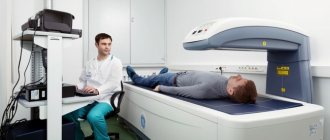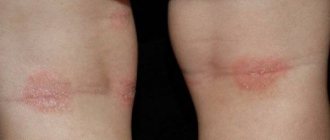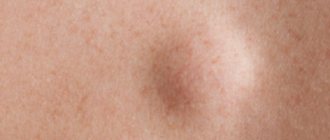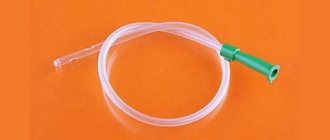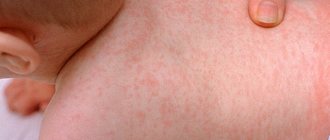Today we will talk about hemorrhagic disease of newborns, as well as the clinical protocol for its diagnosis and treatment. In some countries, prevention of this disease is mandatory, because it can cause dangerous consequences for the baby’s health. Fortunately, this disease occurs infrequently, but parents still need to know what to do if their child is diagnosed with this disease.
general information
Hemorrhagic syndrome in newborns is manifested by poor blood clotting, due to vitamin K deficiency. This problem occurs in a small number of newborns - only 0.2-1.5%. These incidence rates are relevant for post-Soviet countries. And in those regions where newborns are injected with vitamin K for prevention, these numbers are much lower, about 0.1%.
There are three forms of this disease:
- early, or primary form;
- classic shape;
- late, or secondary form.
Although breastfeeding is the healthiest thing for newborn babies, studies have shown that breastfed babies have a slightly higher risk of developing this disease than bottle-fed babies.
Features of vitamin K and its importance in the functioning of the body
Up to ten proteins are involved in the process of blood clotting, 5 of which are synthesized with the help of vitamin K. In addition, it is of no small importance in the process of blood thickening that occurs in the liver. With the help of this vitamin, the human body retains released microelements such as calcium, which plays an important role in the functioning of the skeletal system.
A lack of vitamin K causes detrimental harm to the body. Therefore, if its deficiency occurs, it is necessary to immediately begin to eliminate this pathology. In adults, deficiency of this vitamin is much less common than in children. Since the body of an adult can compensate for its deficiency by consuming vegetables and other foods.
Causes
The main causes of this disease in newborns are considered to be:
- Insufficiency of synthesis of blood clotting factors. Since the formation of these factors occurs in the liver under the influence of vitamin K, a deficiency of this vitamin leads to the production of immature factors. They have a negative charge on the surface, so they cannot bind with calcium and other substances necessary for this. As a result of these processes, fibrin is not formed, which causes weak blood clotting.
- Vitamin K deficiency can occur in the womb due to several factors. For example, if a woman took anticoagulants, aspirin, antibiotics not intended for pregnant women, anticonvulsants and a number of other medications. It is also worth remembering that vitamin K poorly penetrates the placenta during fetal development.
- Prematurity of the baby can also cause this disease.
- It is believed that the cause of early hemorrhagic disease is vitamin K deficiency.
- Late hemorrhagic disease of newborns depends on other factors, namely prematurity and weakness of the child’s body.
- This disease can be provoked by toxicosis and gestosis of the mother.
- Sometimes the cause is impaired liver function in newborns.
Hemorrhagic diathesis in children: causes, symptoms, methods of treatment and prevention
In pediatrics, hemorrhagic diathesis refers to pathologies of the circulatory system, accompanied by the same manifestation - spontaneous bleeding. This disease is quite common in children. The disease affects both adults and children.
Hemorrhagic diathesis (vasculitis) is divided into 2 groups: congenital and acquired.
A genetic defect that is hereditary leads to a hemorrhagic diathesis of a congenital nature. A blood disease or vascular pathology can cause an acquired disease.
Features of the problem
Hemorrhagic diathesis is a consequence of a violation of any part of hemostasis. About 300 different forms of diathesis are described in the medical literature, however, with all the diversity of this disease, they all have one common feature: increased bleeding syndrome. The severity of the symptom can be very different - from small pinpoint rashes and hematomas to massive internal bleeding.
According to statistics, about 5 million inhabitants of the planet suffer from the primary form of diathesis. The prevalence of secondary forms is literally incalculable.
The causes of the disease are extremely varied, often representing a complex of various types of damage, which together lead to impaired blood clotting.
The disease has no age restrictions and affects men and women equally.
Complete healing is impossible in most cases, but timely and competent treatment helps to significantly reduce the severity of symptoms and eliminate the threat of massive bleeding.
Hemorrhagic diathesis in adults
Main symptoms of internal bleeding
Manifestations of hemorrhage depend on the type of bleeding and its location. While external bleeding is fairly easy to detect, internal bleeding is often not noticeable. It can be identified by a number of specific symptoms, such as:
- general malaise;
- dizziness and fainting;
- unnatural pale skin;
- apathy, drowsiness;
- tachycardia;
- decrease in blood pressure.
These are common symptoms of internal bleeding. There are also a number of specific signs characteristic of certain types of hemorrhages.
Classification
Quantitative and qualitative types of diathesis are extremely numerous. They are classified in relation to the mechanism of stopping bleeding.
In a healthy body, restoration of a vessel after damage looks like this:
- blood pours into the perivascular space - into the tissue around the rupture, and thereby compresses the vessel;
- the damaged vessel spasms;
- under the influence of substances released into the blood, platelets stick together and, forming a blood clot, plug the gap;
- under the influence of hormones - norepinephrine, serotonin, adrenaline, released from destroyed platelets, the vessel contracts;
- the thrombus is “reinforced” by connective tissue;
- the walls of the vessel are healed and the vessel restores its integrity.
Excessive and repeated bleeding is caused by disturbances at some stage of recovery.
By platelets
The latter provide the creation of a mechanical barrier that stops bleeding and are a source of hormones necessary for vessel contraction. There are 2 types:
- Thrombocytopenia is a disease in which the concentration of platelets in the blood is below 150 109/l. Most often, this indicates their increased destruction or insufficient synthesis;
- thrombocytopathy - the quantitative level of platelets may be normal or slightly reduced. But at the same time, the blood plates themselves are defective and do not perform their function.
Hemorrhagic diathesis in children - the topic of the video below:
By coagulopathies
Coagulation is blood clotting. This is the primary stage of hemostasis, in which the vessel narrows and the damaged area is clogged with platelets. Primary hemostasis in a healthy body takes 1–3 minutes. According to the degree of violation of this factor, group 2 of hemorrhagic diathesis is distinguished.
Hemorrhagic coagulopathies are caused by deficiencies or abnormalities of plasma coagulation factors. A typical representative of this group is hemophilia A. Most often, such ailments are “associated” with other diseases: skin diseases, kidney and liver failure.
Coagulopathies are distinguished according to the genesis of dysfunction:
Symptoms
Hemorrhagic disorders in newborns manifest themselves as follows:
- In the primary form of the disease, symptoms appear on the second to fourth day of a newborn’s life. This can be various bleedings: nasal, intestinal, and in rare cases, dangerous pulmonary hemorrhages.
- Sometimes hematomas (ecchymosis) appear on the newborn's skin.
- You may also vomit or have bloody stools. Stool with hemorrhagic disease is similar to meconium, it is also black, but with the difference that an admixture of blood is clearly visible in it. A red border of black stool may remain on the diaper.
- In the secondary form, this disease manifests itself in the second to seventh week of the baby’s life. She has signs of infection or hypoxia. In this case, the same symptoms are possible as in the primary form, plus brain bleeding and various blood clotting pathologies.
- Sometimes there is swelling on the head with pinpoint subcutaneous hemorrhages, bleeding from the navel and renal hemorrhages.
Features of symptoms
The clinical picture of the early form of the disease appears immediately after the birth of the baby. In addition to the presence of hemorrhagic spots on the buttocks and other parts of the body, a cephalohematoma forms in the periosteum area. The pathology is accompanied by hemorrhages; signs appear depending on the organ in which they appear:
- The liver increases in size, the baby has a stomach ache.
- When it enters the lungs, shortness of breath occurs, and red sputum is produced when coughing.
- The child becomes weaker and refuses to eat if hemorrhage occurs in the adrenal glands.
With this form of anomaly, anemia develops and neurological disorders are observed. The baby is suffering from bloody vomiting.
In the classic type of the disease, red spots cover the entire body, and ulcers form on the intestinal mucosa. Blood appears in the urine.
The late form is manifested by multiple hematomas on the skin and severe anemia. Hemoglobin drops sharply, thermoregulation is disrupted.
In the absence of urgent help for internal hemorrhages, the consequences can be very sad.
Diagnostics
- To diagnose this problem, you need to test your blood for platelet count.
- The rate of blood clotting and bleeding time are also determined.
- It is also necessary to find out the hemoglobin level of the newborn and find out if he has anemia.
- In the first days of a newborn's life, maternal blood may be present in his vomit or stool. To determine for sure whether it is bleeding or involuntary swallowing of maternal blood, you need to do a special test.
- To determine internal bleeding and effective treatment, an ultrasound examination is performed.
- To determine renal hemorrhages, a general urine test is performed.
Prevention
It cannot be said that any bleeding in the first few days of a baby’s life is a hemorrhagic disease in newborns. Treatment for preventive purposes, however, is still carried out. It consists of intramuscular injection of vitamin K. It is also necessary to monitor the thrombotest in order to monitor the alignment of K-vitamin-dependent blood coagulation factors.
Prevention is also carried out in cases where the baby was born from a pregnancy that occurred with severe toxicosis. "Vikasol" in such situations is administered once. Similar preventive measures are carried out for newborns in a state of asphyxia, which is a consequence of intrauterine infection or received during birth intracranial trauma.
Women who have previously had pathologies associated with bleeding should be under close medical supervision throughout pregnancy.
Treatment
Vitamin K3 is most often used to treat this disease. It is administered intramuscularly once a day for 2-3 days. In case of severe bleeding, fresh frozen plasma is administered intravenously for emergency treatment.
Sometimes glucocorticoids, vitamin A and calcium gluconate may be prescribed for treatment.
Forecast
With an uncomplicated course of hemorrhagic disease, the prognosis is favorable. With timely and correct treatment, the newborn recovers quickly and subsequently does not transform into more severe forms of the disease.
Severe stages of the disease or untimely initiation of treatment can provoke central nervous system diseases.
In rare cases, if measures are not taken to overcome shock, hemorrhagic disease can be fatal.
What are the forecasts?
If the pathology proceeds without complications, then the prognosis is considered to be quite favorable. Vitamin K is administered over several days, which normalizes the synthesis of blood factors and eliminates the problem. However, the very fact of hemorrhage can have various consequences. If a cerebral hemorrhage occurs, then approximately every third baby may experience quite severe forms of damage to the central nervous system. No one can predict the consequences; everything will depend on which parts of the brain are damaged. In severe cases, death is possible. In moderate cases – disability.
It is noteworthy that after recovery, hemostasis disorders usually do not occur, that is, the problem is completely solved. Relapses also usually do not occur. Even after increased bleeding, after a single normalization of the synthesis of coagulation factors, recurrent pathologies do not occur.
Clinical recommendations of the Ministry of Health suggest administering Vikasol to all children at risk in the first hours after birth as a preventive measure. This group includes babies born prematurely (before 38 weeks of pregnancy), children who received any injuries during childbirth, as well as all babies who were born weakened, are bottle-fed, are fed through a tube, which is administered antibiotics according to indications.
To prevent primary hemorrhagic disease, women during pregnancy should monitor their diet, drink vitamins prescribed by their doctor, and not take anticoagulants, antibiotics, and anticonvulsants without prescription. If diseases occur during pregnancy, it is recommended not to self-medicate, but to take adequate therapy. You need to visit the antenatal clinic on time, do general blood and urine tests, without missing a single referral, and do not refuse ultrasound diagnostics.
Interesting topics
- All women gain weight during childbirth. This is due not only to the growth of the abdomen; many mothers develop excess weight in the hips and not only. In this article we will answer the question, how to lose weight after childbirth?
- The birth of a child is not only a long-awaited joy, but also a certain amount of stress for the mother, especially in the first days, when the tummy sags and the woman wants to regain her previous proportions. Find out how to remove belly fat after childbirth.
- Do you know how to deal with stretch marks after childbirth? Is it possible to get rid of them, or do we need to take measures in advance?
- Hemorrhoids after childbirth bother a large number of mothers. Find out which treatment is safest for the mother and her infant.
Girls, have you encountered hemorrhagic disease of newborns? Describe in your comments how early your baby was diagnosed with this disease and what treatment you were prescribed?
Hemorrhagic disease of the newborn
Hemorrhagic disease of newborns or why you shouldn’t rush to be discharged on the 3rd day, as well as about the 1st maternity hospital, about doctors, about the neonatal intensive care unit and much more...
Girls, I know I disappeared, I didn’t even respond to your congratulations. I'll explain why below. I also sincerely congratulate everyone who gave birth during this period!!! Vlada, Tanyushka, Irochka! Let your children grow up healthy!
There will be a lot of text, because... Perhaps our experience can be useful to someone.
Let me make a reservation right away: now my son and I have been at home for more than a month, but we go to the doctors for examinations.
Where to begin?..
I’ll start with the fact that I gave birth not to anyone, but to the head of the department, Larisa Viktorovna Shestak, the birth is negotiable. This turned out to be an important factor.
The birth was not easy, but the baby was born healthy, he immediately screamed, 8/8 apgar, they laid it on my stomach, then put it on my chest, in general, everything was as it should be. There were no signs of problems, but for some reason our doctor decided not to discharge us on the 3rd day, although I really wanted to, for which I thank her very much.
Problems began to appear on the 2nd day. The baby vomited a little something brown. My mother was with me at that time, and because... I was still in serious condition, she took care of the baby. My mother didn’t tell me that the baby had burped, so that I wouldn’t worry, and just gave the diaper to my husband to wash.
During the rounds, the mother informed the pediatrician on duty about this, and the pediatrician immediately said that this was most likely amniotic fluid, which the baby had swallowed during childbirth. This happens, and it's not scary. But it’s bad that we didn’t leave the diaper for her to look at.
Rule! Always control what and how much your baby spits up! If this is not “curd”, then save the thing that the child burped on and show it to the doctors right away!
Otherwise, everything was fine with the child, and we calmed down.
And on the morning of the 3rd day the baby burped brown again. And then again. The baby was very quickly taken for tests, although the doctors still assumed that it was amniotic fluid. Then Larisa Viktorovna came to see me, I told her about the baby. I don’t know if she had an influence, or if it was a coincidence, but soon the head of newborn physiology, Tatyana Andreevna, came to see us. She asked about everything that happened and said that the test results would take about an hour. Half an hour passed and she already came with the results. She said that the tests were bad, something was too high in the blood, a suspicion of hemorrhagic disease (what is this??? I thought) and took the child to the physiology department so that he would be there under observation. He was put on IVs and given antibiotics, because... It turned out that he also had some kind of infection. I am a person very far from medicine, I generally have a creative profession, in my 27 years I have never, thank God, been in a hospital; everything the doctors told me was mixed into a bunch of unfamiliar terms and growing anxiety for my son. I immediately went to read about hemorrhagic disease on the Internet, but I didn’t really understand anything, except that it is a deficiency of vitamin K, which is responsible for blood clotting, and that it is a very rare disease, according to statistics.
Breastfeeding was prohibited. All night, every 3 hours, I tried to pump so that my son could be fed from a syringe. Because I still had colostrum, it was very difficult to express and I only got a few ml. In general, as much as I didn’t want to, I had to supplement the baby with formula. The next morning, my husband and I went to see the baby to check on him, and the doctor made me happy by allowing me to put him to the breast, because... everything was fine at night. I, happy, fed Max, then we put him in the crib, and while I was talking with the doctor, my husband saw that my son was bleeding from his mouth! ((( dark thick blood! How scared we were, it’s impossible to describe. Confusion, Max They took me to the intensive care unit. My husband sent me to the ward, scolded me for crying, and he himself went to the intensive care unit to wait for news. He came an hour later, pale and with a list of medications. He said that they didn’t really explain anything to him, they just handed him the list and left for the pharmacies .
During the time he was traveling, I learned that babies in the intensive care unit can be visited 3 times a day: at 15, 18 and 21 hours. At 15.00 you can ask the manager about the child’s condition. Or rather, it was even written that you can visit him at any time, but in order not to interfere with treatment, it is better to do it during the allotted hours.
I tried to break through to my child, but they didn’t let me in. Thanks to the nurse on duty, Natasha, that she at least treated me like a human being and, whenever I looked in, she told me about Maxim’s condition. And it was heavy. At 15.00 the head informed us that the diagnosis was a hemorrhagic disease, and that the child would be on IVs and a probe for several days, and also under a lamp, because... jaundice appeared. And you can't feed him either. Nothing. At all. Because this can cause hemorrhages. Through droppers they will give glucose and the drug Aminoven, these are proteins. Or rather, we found out about Aminoven only 2 days later, when we were told to buy it in exchange for what they used from their reserves. By the way, the drug turned out to be expensive and very scarce; we still had to administer it for almost a week. Well, after a conversation with the manager, I was finally allowed to see the baby. Only mothers are allowed there and only in sterile gowns. When I saw my baby, my heart sank: there were catheters in all the veins on the arms and legs, a probe in the mouth, lying naked under the lamp with his eyes closed with a blindfold... HOW diligently he showed me that he wanted to eat! So he stuck his fist in his mouth! I cried so much!.. now I sit and roar when I remember ((((I burst into tears even then, even the doctor on duty promised to kick me out. And my milk also started to come in, my chest hurt terribly... in general, by the evening I myself The temperature rose to 38 and I did not dare to approach the baby with such health, I only found out from the nurse how he was.
In the morning, of course, the first thing I did was go to the intensive care unit, but it was already a different shift, and the nurse refused to talk about the child’s condition. In an icy tone she said to wait for 15.00. I tried to approach Maxim, but they didn’t let me in! No amount of persuasion or explanation that I had not seen him since 6 pm had any effect and they simply locked the door in front of me... In the afternoon, the manager said that my husband and I needed to decide what to inject our baby with: vitamin K, the Hungarian-made Kanavit drug, or the German drug , the same vitamin K, “the same formula,” but it is 2-3 times more expensive. We said we'll think about it. But what exactly were we supposed to think about?! We are not doctors, we don’t understand a damn thing about this! She repeated several times that it was “the same formula,” but she didn’t say why exactly the drug was better. It actually seemed to us that she wanted to sell us some medicine. As a result, I consulted with a doctor I know and we decided not to change the drug to a more expensive one, because... and on Kanavit, in 2 days, improvements actually began. And there may be a negative reaction to another drug.
By the way, the doctor on duty told us everything about the disease itself right on the 3rd day of intensive care. In general, hemorrhagic disease is a deficiency of vitamin K, which is responsible for blood clotting. For some reason, our baby did not fully assimilate it when, like everyone else, it was introduced at birth. As a result, not all vessels became clogged and ulcers formed in the vessels of the gastrointestinal tract. Therefore, after feeding, he began to bleed: his stomach began to contract, the wound opened and blood began to flow. Thank God, we were in the maternity hospital and they immediately provided us with help. There are sad outcomes if you don’t manage to get to the hospital on time...
The doctors did not talk about any consequences. We only learned that sometimes you can stop the disease in a few days and everything is ok. And sometimes it gives some serious consequences.
They allowed me to feed him a little bit of expressed milk right up to the 4th day.
I managed to save milk despite the stress, spent nerves and the ban on feeding. Constantly pumping was very difficult and very painful. It was even more painful to pour out the expressed milk (((Thanks to the nurses, they helped me massage my breasts. In general, over these few days, all my examinations irritated me so much! Either the round will come, then they will send me for an ultrasound, then my doctor will look at me in the chair, then some tests ... What else I noticed is that with any reference to Larisa Viktorovna, all the doctors and nurses suddenly suddenly turned out to be so attentive... it was disgusting. I later started talking with the mothers of other children, when we came for feeding, they all gave birth with the doctors on duty. As a result The husbands of all of them were planning to sue the maternity hospital. It was clear from the ultrasound of one that the child was more than 4 kg, and she was thin and had narrow hips. All indications for a CS. They forced her to give birth herself. She also had a long cervix As a result, the child was born with a hematoma on the head, the girl was immediately taken to the intensive care unit. The mother’s blood vessels burst in her eyes, and in general, poor thing, she could barely walk... and she also told how she was very thirsty and tried to shout to at least someone to bring her a glass of water. Her nurse came up with the words “What are you yelling about?”... and when she found out that the girl had already drunk all her water, she said that she couldn’t help. In general, I barely asked for water from the tap, poor thing...
This, of course, is not like mine - a VIP delivery room with a leather sofa and a shower and everything is the same color, and the manager strokes my hand and assures that everything will be fine...
As soon as the baby was allowed to feed, I finally came to my senses and every 3 hours I brought syringes with expressed milk, and brought more than they said. And she did the right thing, my son ate everything, if not everything was fed at once, then later he demanded to feed him more. Another day later they allowed me to come and breastfeed + bring expressed milk. It was a blessing, but it was very difficult: you can’t sit with a stitch after an episiotomy, i.e. in intensive care you can only feed while standing, and the baby was still very weak and feeding lasted an hour, or even more, he would eat for 5 minutes and sleep in his arms for 10 minutes. There was almost no time left for sleep... It was during these hour-long feedings that the girls and I became separated.
What else I would like to note... I was embarrassed that on the 4-5th day the child’s eyes practically did not open, the swelling was so severe, and they also began to connect catheters through the veins on the forehead. It seemed to me that my eyes were turning sour. I asked doctors and nurses, they waved me off and said that everything was ok, it would pass. In general, I eventually brought the doctor on duty, Irina Removna, one of the most normal ones, to the child, and she finally prescribed eye drops. And this shift regularly covered my baby’s eyes, and the next shift didn’t pay attention to the fact that they were standing in a visible place. I had to remind them every time to drip. In general, of course, the attitude of the staff is just a 'song'... No, there are, of course, very good and sympathetic doctors and nurses, but for every 5 good people there are 2! Doctors answer questions irritably, nurses refer you to doctors for every question... And you feel as if you are drowning, there are a lot of people around and no one will throw you at least a life preserver... No, the attitude of individuals immediately changed as soon as they found out that I was in the VIP ward after giving birth. It's so disgusting! Well, is it really necessary to show that you have money and connections so that the attitude is at least just human?!
The situation hit me on the baby’s last night in the intensive care unit. The girls and I arrive at 3 a.m. for feeding, and the intensive care ward is simply open, and there is NO staff in it!!! There are 4 newborns lying unattended, the intensive care unit is open! We were shocked. But they thought maybe the nurse on duty came out for a couple of minutes and that’s it. But no! We fed the children and no one came. There is no clock in the room; we felt out of time and space there, because... Of course, we didn’t take our phones with us, and we didn’t really sleep for several days. Then one mother decided to go to the staff room and call at least someone. A FIRST manipulative sister comes and immediately attacks us that we have been FEEDING TOO LONG! We ask her what time it is, and it turns out that we’ve been feeding for just over half an hour... And she tried to kick us out, like it’s supposed to be 15-20 minutes. Of course, we fed the children as expected. But I personally was in awe, sorry. My only regret is that I didn’t file a complaint for their entire shift. But the next morning the manager made me happy that the baby was being sent to my ward, and out of happiness I decided not to spoil my nerves with a scandal.
As a result, we spent a week in intensive care. We spent several more days under observation in the ward. Every day, the head of physiology, Tatyana Andreevna, came in several times. Thank you very much for your attention, of course. She was concerned about the venous network throughout the baby's body and weak muscle tone. She agreed at Okhmatdyt, we went for a neurosonogram, because... She immediately said that these were neurological disorders. The neurosonogram turned out to be good and the next day we were finally discharged, with a strong recommendation to see a neurologist as soon as possible.
We got home exactly at our 2 weeks. Tired of what was happening, but happy that the whole family was together. There are still many examinations ahead, we have already completed some of them, but this is another post and about the 7th children's clinic (there is also something to tell there).
By the month my son had gained his 800 grams, despite a week of intensive care. He eats his cheeks very diligently))) we eat well, walk and are already 'talking')) We go swimming for babies, Max really likes it. In general, I really hope that everything is behind us, we are doing our best to give our son everything he needs to be healthy.
What did I take away from all this?.. 1. You need to sleep a lot before giving birth. I’m a fool, the night before I chose a walk in the fresh air, but I should have slept. The birth started at night, and I didn’t have the strength for it. Maybe all our complications wouldn’t have happened if I had been well rested.
2. Our medicine is shit. This is not a new fact, of course, but that doesn’t make it any less sad. It always seems that you need to get medical education yourself in order to be calm about your child.
3. If possible, negotiate and pay in advance! Find connections, money, good doctors - by any means necessary.
4. Even though there was a very good doctor at my birth, I’m not sure that the second child (God willing)

